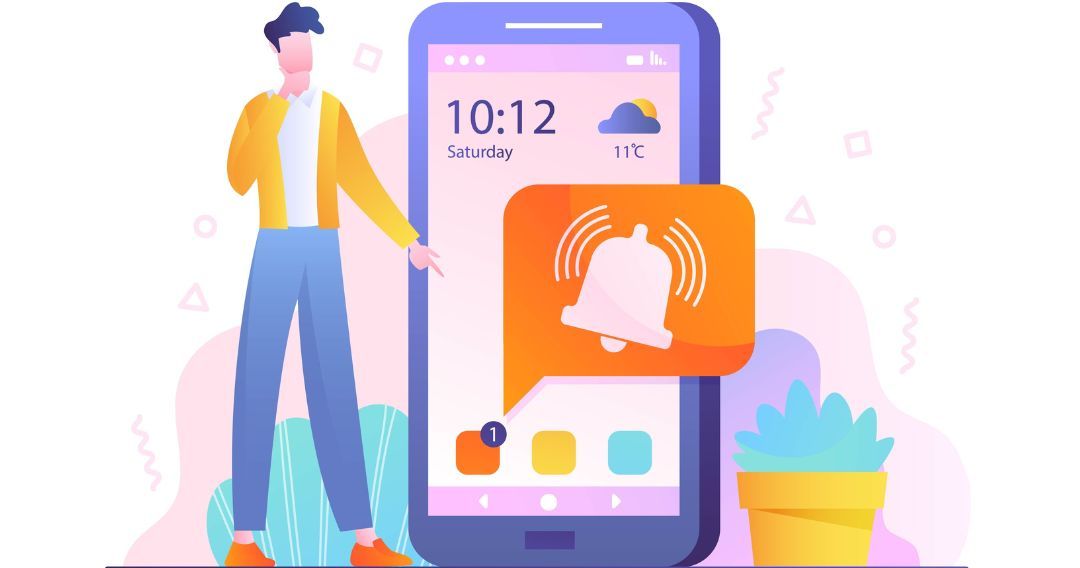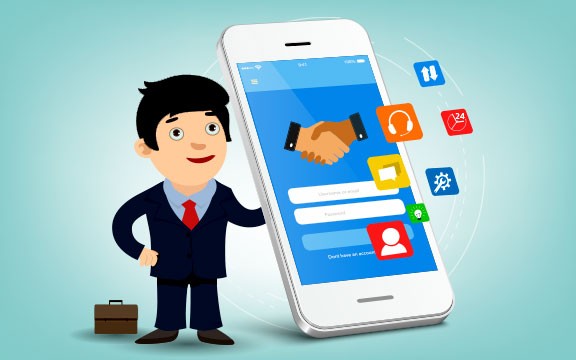Most people stay close to their smartphones throughout the day. At any given time, they may check their phone when they receive a text message, filter through their email, or see what their friends are up to on social media.
In fact, according to Zippia, the average American picks up their phone an astonishing 96 times daily. That’s approximately once every 15 minutes.
If you’re a marketer, getting in front of your competition by sending your customers push or SMS messages probably ranks pretty high on your to-do list. After all, you want to be where your customers are. So if they’re on their phones, getting your company seen through SMS and push messages is a good strategy.
However, sometimes organizations aren’t sure whether a push or an SMS message is the right option. In this article, we’ll discuss what SMS and push notifications are and how to decide which is most suitable for your marketing strategy.
SMS vs. Push Notifications: What They Are
An SMS message is a simple text that appears on your recipient’s phone in their text message inbox. Like a regular text message, it comes directly to their phone number, usually via a short code or a dedicated business phone number that you use to connect with your clients.
Most SMS messages are short. They don’t contain any multimedia features, like pictures or GIFs. Otherwise, they’d be an MMS message. Businesses can use both SMS and MMS communications with their clients through a messaging service like Contact Consumers.
By contrast, push notifications are those sent not through a phone number but through apps. They therefore only appear to clients who have your company’s app downloaded onto their devices, and an app is required to send them. Push notifications appear on the notification bars of people’s smart devices and — depending on the type used — can communicate a combination of text and media.
Understanding SMS vs. Push Notifications
If you are wondering about SMS vs. push notifications, you’ll want to understand their key differences and how customers are likely to interact with them.
SMS Messages
Clients can only receive SMS messages if they provide you with a specific permission to text them. For instance, if they provide their phone number when ordering a product from you and agree to accept your SMS communications, you can contact them via SMS. If you don’t have their permission and text them anyway, you can end up in legal trouble.
SMS messages have a high open rate that you aren’t likely to find through other channels, like email. The average open rate for an SMS text is 98%. Nearly all customers receiving your messages will likely open them.
An SMS message also has a high visibility rate. They’ll appear on top of any push notifications the recipient gets. This means that if your customer hasn’t checked their phone in a few hours and received a mix of push notifications and SMS texts in that time, the texts will appear at the top of the list.
Most SMS messages require some type of engagement from the recipient. For instance, a marketing SMS text might include a link to the company’s store for a promotional opportunity. Customers can respond to the SMS texts they receive if they wish to engage with you further.
Finally, a customer who chooses to receive SMS texts from you will receive everything you decide to send. You can, though, choose to provide them with a list of SMS text types that they can select from.
For instance, some companies allow clients to choose between status updates, shipping details, and marketing texts. If that’s the case for your company, the recipient should only receive SMS communications that reflect their selected options.
Push Notifications
Push notifications are different from SMS messages. To receive them, the recipient must download your app. They’ll start receiving your push messages once they have the app on their phone or another similar device, like a tablet.
Clients are much less likely to read or interact with push notifications. Most have an open rate of under 8%. However, you may see higher open rates depending on how engaging your app is and how often your clients interact with it.

Typically, a push notification will appear as a banner on the phone. It may be accompanied by a sound if you enact that feature in your app and if the recipient allows audible notifications on their phone.
If your client has numerous apps on their phone or several that regularly send out push notifications, you’ll compete with them for your client’s attention. The first push notification typically appears at the top of their list, followed by subsequent ones from other apps.
Clients who have your app have more opportunities to customize how they receive your push notifications. They can opt entirely out of your notifications through the settings on their phone. They can also set times to receive push notifications, such as disallowing any messages after a particular time at night.
Sometimes, clients will see the full text of your push notification if that’s how they set their display notifications up. Others won’t see any message — just the name of your app.
If a customer decides to open your push notification, they’ll go directly to your app. You’ll need to customize the notification so it sends them to content that relates directly to your message. For instance, if you send them a news article through your news app, clicking the push notification should take them directly to that post.
When to Send an SMS Text Message
How do you decide whether to send an SMS text message? Typically, it is most advantageous to send SMS messages in the following situations:
You Have an Urgent Message They Need to See
People check their SMS messages often because friends and family use them to communicate. They won’t want to miss an urgent text from someone they know. Similarly, if you have an urgent message your clients need to be aware of, you’ll want to tell them over text.
For instance, if you’re an educational provider, parents of students who attend your school will want to know if you’re closing early for inclement weather. Similarly, if you run a physical storefront and don’t plan to be open for a holiday, sending a text is a good idea so clients know not to make the trip out to your location.
A Delivery or Purchase Confirmation Update
Once a client places an order with you, they’ll probably opt to receive delivery updates. After all, they want to know where their purchase is and when you expect to have it shipped to them.
Sending a delivery update or purchase confirmation through SMS exemplifies good customer service. It ensures clients know you received their order and that you’re getting it to them as quickly as possible.
You Want to Remind Them of an Upcoming Appointment
You (and your customers) are busy people. If you have an upcoming appointment together, you’ll want to ensure they haven’t forgotten about you. Otherwise, you’ll be waiting for someone who doesn’t plan to show up.
A quick reminder SMS sent a day or two before the appointment makes sure that everyone is on the same page. If they can’t make the appointment for some reason, they can reply to your text and reschedule, saving everyone an avoidable headache.
You Want to Alert Them to Potential Fraud
Did you notice that someone placed an order with you using your client’s information, but something about it seems fishy? For instance, perhaps they’re using a different address, or they requested a password update before making their purchase.
You should always send a client an SMS text when you notice abnormal activity on their account with you. You’ll build trust with your client and protect them from others attempting to steal their account information.
You’re Having a Major Sale
Retailers and other service providers frequently use promotional activities to encourage sales. While sending your client a daily (or even weekly) sales message probably isn’t a good idea, they’ll want to know if you’re offering a significant promotion or a deal on something you know they’ll want.
Try to stretch out your sales SMS texts so that they’re not the only type of communication clients receive from you. However, do use SMS texts to contact them if you’re having an annual sales blowout or if there’s a major clearance at your store for the season.
When to Send Push Notifications
If you have an app for your business, you can send clients push notifications you think they’ll want to see. There are a few scenarios in which push messages make sense.
You Need Your Clients to Update Your App
Apps frequently need updating, and you’ll want to notify your clients when one becomes necessary. Otherwise, their app may not work correctly the next time they use it. A push notification is effective for accomplishing an app update. Simply send the message, and they can act on it when they have a few minutes.
Regular Sales or Discounts
If you frequently offer sales and discounts that promote your products and services, a push notification is the best way to notify your customers without being repetitive. Customers can ignore the communication if they’re uninterested or click on the message to visit your app. Save your best sales invites for your SMS recipients.
Requests for Feedback
You want to know how your customers feel about your company. You can use their feedback to improve your products or services or learn where you’re not performing entirely to their expectations.
Push notifications are great for soliciting feedback. You can create a customized page in your app that customers can quickly respond to, and you’ll receive their comments directly.
Understanding the Difference Between SMS and Push Communications
Once you know the difference between SMS and push notifications, it’s easier to determine which is most appropriate for customer communications. While SMS messages are better for urgent content, you can send push notifications more frequently without annoying your customers to the same degree. Given your objectives, use our guide to decide which one is most appropriate.
Are you looking for a reliable SMS and email messaging platform that can help you connect with your clients? Contact Consumers might be the right option for you. Check out our SMS and MMS messaging service to learn more about our services.




